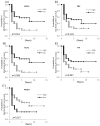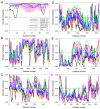Cancer/Testis Antigens: "Smart" Biomarkers for Diagnosis and Prognosis of Prostate and Other Cancers
- PMID: 28362316
- PMCID: PMC5412325
- DOI: 10.3390/ijms18040740
Cancer/Testis Antigens: "Smart" Biomarkers for Diagnosis and Prognosis of Prostate and Other Cancers
Abstract
A clinical dilemma in the management of prostate cancer (PCa) is to distinguish men with aggressive disease who need definitive treatment from men who may not require immediate intervention. Accurate prediction of disease behavior is critical because radical treatment is associated with high morbidity. Here, we highlight the cancer/testis antigens (CTAs) as potential PCa biomarkers. The CTAs are a group of proteins that are typically restricted to the testis in the normal adult but are aberrantly expressed in several types of cancers. Interestingly, >90% of CTAs are predicted to belong to the realm of intrinsically disordered proteins (IDPs), which do not have unique structures and exist as highly dynamic conformational ensembles, but are known to play important roles in several biological processes. Using prostate-associated gene 4 (PAGE4) as an example of a disordered CTA, we highlight how IDP conformational dynamics may regulate phenotypic heterogeneity in PCa cells, and how it may be exploited both as a potential biomarker as well as a promising therapeutic target in PCa. We also discuss how in addition to intrinsic disorder and post-translational modifications, structural and functional variability induced in the CTAs by alternate splicing represents an important feature that might have different roles in different cancers. Although it is clear that significant additional work needs to be done in the outlined direction, this novel concept emphasizing (multi)functionality as an important trait in selecting a biomarker underscoring the theranostic potential of CTAs that is latent in their structure (or, more appropriately, the lack thereof), and casts them as next generation or "smart" biomarker candidates.
Keywords: biomarkers; cancer/testis antigens; centrosomal protein of 55 kDa (CEP55); intrinsically disordered protein; nucleolar protein 4 (NOL4); prostate cancer; prostate-associated gene 4 (PAGE4).
Conflict of interest statement
The authors declare no conflict of interest.
Figures





Similar articles
-
Cancer/Testis Antigens as potential predictors of biochemical recurrence of prostate cancer following radical prostatectomy.J Transl Med. 2011 Sep 14;9:153. doi: 10.1186/1479-5876-9-153. J Transl Med. 2011. PMID: 21917134 Free PMC article.
-
Prostate-associated gene 4 (PAGE4), an intrinsically disordered cancer/testis antigen, is a novel therapeutic target for prostate cancer.Asian J Androl. 2016 Sep-Oct;18(5):695-703. doi: 10.4103/1008-682X.181818. Asian J Androl. 2016. PMID: 27270343 Free PMC article. Review.
-
Cancer/testis antigens: novel tools for discerning aggressive and non-aggressive prostate cancer.Asian J Androl. 2012 May;14(3):400-4. doi: 10.1038/aja.2011.144. Epub 2012 Feb 20. Asian J Androl. 2012. PMID: 22343492 Free PMC article. Review.
-
The cancer/testis antigen prostate-associated gene 4 (PAGE4) is a highly intrinsically disordered protein.J Biol Chem. 2011 Apr 22;286(16):13985-94. doi: 10.1074/jbc.M110.210765. Epub 2011 Feb 25. J Biol Chem. 2011. PMID: 21357425 Free PMC article.
-
Nanowire analysis of cancer-testis antigens as biomarkers of aggressive prostate cancer.Urology. 2015 Mar;85(3):704.e1-7. doi: 10.1016/j.urology.2014.12.004. Urology. 2015. PMID: 25733303 Free PMC article.
Cited by
-
CT45A1 promotes the metastasis of osteosarcoma cells in vitro and in vivo through β-catenin.Cell Death Dis. 2021 Jun 25;12(7):650. doi: 10.1038/s41419-021-03935-x. Cell Death Dis. 2021. PMID: 34172717 Free PMC article.
-
Diagnostic and prognostic value of CEP55 in clear cell renal cell carcinoma as determined by bioinformatics analysis.Mol Med Rep. 2019 May;19(5):3485-3496. doi: 10.3892/mmr.2019.10042. Epub 2019 Mar 15. Mol Med Rep. 2019. PMID: 30896867 Free PMC article.
-
Prostate cancer health disparities: An immuno-biological perspective.Cancer Lett. 2018 Feb 1;414:153-165. doi: 10.1016/j.canlet.2017.11.011. Epub 2017 Nov 15. Cancer Lett. 2018. PMID: 29154974 Free PMC article.
-
The expression, modulation and use of cancer-testis antigens as potential biomarkers for cancer immunotherapy.Am J Transl Res. 2020 Nov 15;12(11):7002-7019. eCollection 2020. Am J Transl Res. 2020. PMID: 33312347 Free PMC article. Review.
-
The Structural and Functional Diversity of Intrinsically Disordered Regions in Transmembrane Proteins.J Membr Biol. 2019 Oct;252(4-5):273-292. doi: 10.1007/s00232-019-00069-2. Epub 2019 May 28. J Membr Biol. 2019. PMID: 31139867 Free PMC article. Review.
References
-
- Dubben H.H. Prostate-cancer screening. N. Engl. J. Med. 2009;361:204. author reply 204–206. - PubMed
-
- Hayes J.H., Ollendorf D.A., Pearson S.D., Barry M.J., Kantoff P.W., Stewart S.T., Bhatnagar V., Sweeney C.J., Stahl J.E., McMahon P.M. Active surveillance compared with initial treatment for men with low-risk prostate cancer: A decision analysis. JAMA. 2010;304:2373–2380. doi: 10.1001/jama.2010.1720. - DOI - PMC - PubMed
Publication types
MeSH terms
Substances
LinkOut - more resources
Full Text Sources
Other Literature Sources
Medical

